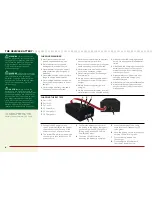
12
The largest factor in run time is the
capacity of the battery pack. A larger
mAh rating increases the amount
of run time experienced.
The condition of a battery pack is
also an important factor in both run time
and speed. The battery connectors may
become hot during driving. Batteries will
lose performance and capacity over time.
Driving the vehicle from a stop to
full speed repeatedly will damage the
batteries and electronics over time.
Sudden acceleration will also lead
to shorter run times.
to iMProVe run tiMeS
»
Clean and oil bearings often. If bearings
are dirty, they will increase friction and
cause reduced performance.
»
Keep your vehicle clean and maintained.
»
Allow more airflow to the ESC
and motor.
»
Change the gearing to a lower ratio.
A lower ratio decreases the operating
temperature of the electronics. Use
a smaller pinion gear or larger spur
gear to lower the gear ratio.
»
Use a battery pack with a higher
mAh rating.
driVinG PrecautionS
»
Maintain sight of the vehicle at all times.
»
Routinely inspect the vehicle for loose
wheel hardware.
»
Routinely inspect the steering assem-
bly for any loose hardware. Driving the
vehicle off-road can cause fasteners
to loosen over time.
»
Do not drive the vehicle in tall grass.
Doing so can damage the vehicle
or electronics.
»
Stop driving the vehicle when you
notice a lack of power. Driving the
vehicle when the battery is overly
discharged can cause the receiver to
power off. If the receiver loses power,
you will lose control of the vehicle.
»
Do not apply forward or reverse throttle
if the vehicle is stuck. Applying throttle
in this instance can damage
the motor or ESC.
»
After driving the vehicle, allow the
electronics to cool before driving the
vehicle again. Remove the body of
the vehicle to reduce cooling time.
run tIme
/ / / / / / / / / / / / / / / / / / / / / / / / / / / / / / / / / /
/ / / / / / / / / / / / / / / / / / / / / / / / / / / / / / / / / / / / / / / / / / / / / / / / / / / / / /
»
Examine your vehicle on a regular basis.
»
Use a brush to remove dirt and dust.
»
Look for damage to the suspension arms
and other molded parts.
»
Re-glue the tires to the wheels, if necessary.
»
Clean and oil all wheel bearings.
»
Use suitable tools to tighten fasteners.
»
Make sure the camber and steering linkages
are not bent. Replace any bent linkages.
»
Adjust the Toe and Camber settings, if necessary.
»
Remove the shocks and inspect them for
damage. Rebuild the shocks if oil is leaking.
»
Inspect electronics and batteries for exposed wires.
Repair exposed wires with shrink-wrap, or replace the wire.
»
Make sure the ESC and receiver are secure on
the chassis. Replace the double-sided tape,
if necessary.
»
Power ON the transmitter. If the green LED is dim
or off, replace the AA batteries in your transmitter.
»
Check the spur gear and pinion gear for wear.
tunInG, adjustInG & maIntaInInG your vehICle
/ / / / / / / / / / / / / / / / / / / / / / / / / / / / / / / / / / / / / / / / / / / / / / / / / / / / / /
SerVice/rePair
If any problems other than those
covered in this manual arise, please
call the appropriate electronics service
department. Refer to the Warranty and
Service Information section for the ap-
propriate department to contact.
cleaninG
Performance can be hindered if dirt
gets in any of the moving suspension
parts. Use compressed air, a soft paint-
brush, or a toothbrush to remove dust
or dirt. Avoid using solvents or chemi-
cals as they can actually wash dirt into
the bearings or moving parts, as well
as cause damage to the electronics.
Before runninG your Vehicle
1
Check for free suspension
movement. All suspension arms
and steering components should
move freely. Any binds will cause
the vehicle to handle poorly.
2
Charge the battery.
3
Check the calibration of the ESC.
If recalibration is required, follow
the setup instructions.
4
Adjust the transmitter settings
to your desired configuration.





































